Immobilisation of Molybdenum in a Sulphate-Reducing Bioreactor
Abstract
:1. Introduction
2. Materials and Methods
2.1. Sulphate-Reducing Bioreactor
2.2. Experimental Procedure and Analytical Determinations
2.3. Sampling and Physical–Chemical Analysis of the Reactor Precipitates
3. Results and Discussion
3.1. Mo Speciation
3.2. Reduction of Sulphate and Molybdate
3.3. Characterisation of the Reactor Precipitates
4. Conclusions
Author Contributions
Funding
Data Availability Statement
Acknowledgments
Conflicts of Interest
References
- Mitchell, P.C.H.; Outteridge, T.; Kloska, K.; McMahon, S.; Epshteyn, Y.; Sebenik, R.F.; Burkin, A.R.; Dorfler, R.R.; Laferty, J.M.; Leichtfried, G.; et al. Molybdenum and molybdenum compounds. In Ullmann’s Encyclopedia of Industrial Chemistry; Wiley: Hoboken, NJ, USA, 2020; pp. 1–63. [Google Scholar]
- Hund, K.; La Porta, D.; Fabregas, T.P.; Laing, T.; Drexhage, J. Minerals for Climate Action: The Mineral Intensity of the Clean Energy Transition; Climate-Smart Mining Initiative of the World Bank Group: Washington, DC, USA, 2020. [Google Scholar]
- EC. Study on the Critical Raw Materials for the EU 2023—Final Report; Directorate-General for Internal Market, Industry, Entrepreneurship and SMEs: Brussels, Belgium, 2023. [Google Scholar]
- Ong, K.H.; Agileswari, R.; Maniscalco, B.; Arnou, P.; Kumar, C.C.; Bowers, J.W.; Marsadek, M.B. Review on substrate and molybdenum back contact in CIGS thin film solar cell. Int. J. Photoenergy 2018, 2018, 9106269. [Google Scholar] [CrossRef]
- Theocharis, M.; Tsakiridis, P.E.; Kousi, P.; Hatzikioseyian, A.; Zarkadas, I.; Remoundaki, E.; Lyberatos, G. Hydrometallurgical treatment for the extraction and separation of indium and gallium from end-of-life CIGS photovoltaic panels. Mater. Proc. 2021, 5, 51. [Google Scholar] [CrossRef]
- Weckend, S.; Wade, A.; Heath, G. End-of-Life Management: Solar Photovoltaic Panels; International Renewable Energy Agency (IRENA) and International Energy Agency—Photovoltaic Power Systems (IEA-PVPS): Paris, France, 2016; p. 100. [Google Scholar]
- Abejón, R. An overview to technical solutions for molybdenum removal: Perspective from the analysis of the scientific literature on molybdenum and drinking water (1990–2019). Water 2022, 14, 2108. [Google Scholar] [CrossRef]
- Zeng, L.; Yong Cheng, C. A literature review of the recovery of molybdenum and vanadium from spent hydrodesulphurisation catalysts: Part II: Separation and purification. Hydrometallurgy 2009, 98, 10–20. [Google Scholar] [CrossRef]
- Swinkels, P.L.J.; van der Weijden, R.D.; Ajah, A.N.; Arifin, Y.; Loe, H.L.; Manik, M.H.; Siriski, I.; Reuter, M.A. Conceptual process design as a prerequisite for solving environmental problems; a case study of molybdenum removal and recovery from wastewater. Miner. Eng. 2004, 17, 205–215. [Google Scholar] [CrossRef]
- Freedman, M.L. Precipitation of molybdenum (VI) in strongly acid solutions. J. Chem. Eng. Data 1963, 8, 113–116. [Google Scholar] [CrossRef]
- Vollprecht, D.; Plessl, K.; Neuhold, S.; Kittinger, F.; Öfner, W.; Müller, P.; Mischitz, R.; Sedlazeck, K.P. Recovery of molybdenum, chromium, tungsten, copper, silver, and zinc from industrial waste waters using zero-valent iron and tailored beneficiation processes. Processes 2020, 8, 279. [Google Scholar] [CrossRef]
- Moret, A.; Rubio, J. Sulphate and molybdate ions uptake by chitin-based shrimp shells. Miner. Eng. 2003, 16, 715–722. [Google Scholar] [CrossRef]
- Valenzuela, F.R.; Andrade, J.P.; Sapag, J.; Tapia, C.; Basualto, C. The solvent extraction separation of molybdenum and copper from acid leach residual solution of Chilean molybdenite concentrate. Miner. Eng. 1995, 8, 893–904. [Google Scholar] [CrossRef]
- Sato, T.; Watanabe, H.; Suzuki, H. Liquid-liquid extraction of molybdenum(VI) from aqueous acid solutions by TBP and TOPO. Hydrometallurgy 1990, 23, 297–308. [Google Scholar] [CrossRef]
- Lewis, A.E. Review of metal sulphide precipitation. Hydrometallurgy 2010, 104, 222–234. [Google Scholar] [CrossRef]
- Cibati, A.; Cheng, K.Y.; Morris, C.; Ginige, M.P.; Sahinkaya, E.; Pagnanelli, F.; Kaksonen, A.H. Selective precipitation of metals from synthetic spent refinery catalyst leach liquor with biogenic H2S produced in a lactate-fed anaerobic baffled reactor. Hydrometallurgy 2013, 139, 154–161. [Google Scholar] [CrossRef]
- Hamza, M.F.; Roux, J.-C.; Guibal, E. Metal valorization from the waste produced in the manufacturing of Co/Mo catalysts: Leaching and selective precipitation. J. Mater. Cycles Waste Manag. 2019, 21, 525–538. [Google Scholar] [CrossRef]
- Vemic, M.; Bordas, F.; Comte, S.; Guibaud, G.; Lens, P.N.L.; van Hullebusch, E.D. Recovery of molybdenum, nickel and cobalt by precipitation from the acidic leachate of a mineral sludge. Environ. Technol. 2016, 37, 2231–2242. [Google Scholar] [CrossRef] [PubMed]
- Ahmaruzzaman, M.; Gadore, V. MoS2 based nanocomposites: An excellent material for energy and environmental applications. J. Environ. Chem. Eng. 2021, 9, 105836. [Google Scholar] [CrossRef]
- Bhat, K.S.; Nagaraja, H.S. Performance evaluation of molybdenum dichalcogenide (MoX2; X= S, Se, Te) nanostructures for hydrogen evolution reaction. Int. J. Hydrogen Energy 2019, 44, 17878–17886. [Google Scholar] [CrossRef]
- Liang, Z.; Shen, R.; Ng, Y.H.; Zhang, P.; Xiang, Q.; Li, X. A review on 2D MoS2 cocatalysts in photocatalytic H2 production. J. Mater. Sci. Technol. 2020, 56, 89–121. [Google Scholar] [CrossRef]
- Meier, A.J.; Garg, A.; Sutter, B.; Kuhn, J.N.; Bhethanabotla, V.R. MoS2 nanoflowers as a gateway for solar-driven CO2 photoreduction. ACS Sustain. Chem. Eng. 2019, 7, 265–275. [Google Scholar] [CrossRef]
- Gupta, D.; Chauhan, V.; Kumar, R. A comprehensive review on synthesis and applications of molybdenum disulfide (MoS2) material: Past and recent developments. Inorg. Chem. Commun. 2020, 121, 108200. [Google Scholar] [CrossRef]
- Jacob, J.M.; Lens, P.N.L.; Balakrishnan, R.M. Microbial synthesis of chalcogenide semiconductor nanoparticles: A review. Microb. Biotechnol. 2016, 9, 11–21. [Google Scholar] [CrossRef]
- Nelson, D.; Amedea, B.S. Microbial syntheses of metallic sulfide nanoparticles: An overview. Curr. Biotechnol. 2012, 1, 287–296. [Google Scholar] [CrossRef]
- Yanchatuña Aguayo, O.P.; Mouheb, L.; Villota Revelo, K.; Vásquez-Ucho, P.A.; Pawar, P.P.; Rahman, A.; Jeffryes, C.; Terencio, T.; Dahoumane, S.A. Biogenic sulfur-based chalcogenide nanocrystals: Methods of fabrication, mechanistic aspects, and bio-applications. Molecules 2022, 27, 458. [Google Scholar] [CrossRef]
- Postgate, J.R. The Sulphate-Reducing Bacteria; Cambridge University Press: Cambridge, UK, 1979. [Google Scholar]
- Bijmans, M.F.M.; Buisman, C.J.N.; Meulepas, R.J.W.; Lens, P.N.L. Sulfate reduction for inorganic waste and process water treatment. In Comprehensive Biotechnology, 2nd ed.; Murray, M.-Y., Ed.; Academic Press: Burlington, NJ, USA, 2011; pp. 435–446. [Google Scholar]
- Rabus, R.; Hansen, T.A.; Widdel, F. Dissimilatory sulfate- and sulfur-reducing prokaryotes. In The Prokaryotes: Ecophysiology and Biochemistry, 3rd ed.; Dworkin, M., Falkow, S., Rosenberg, E., Schleifer, K.-H., Stackebrandt, E., Eds.; Springer: New York, NY, USA, 2007; Volume 2, pp. 659–768. [Google Scholar]
- Kumar, M.; Nandi, M.; Pakshirajan, K. Recent advances in heavy metal recovery from wastewater by biogenic sulfide precipitation. J. Environ. Manag. 2021, 278, 111555. [Google Scholar] [CrossRef]
- Hockin, S.L.; Gadd, G.M. Bioremediation of metals and metalloids by precipitation and cellular binding. In Sulphate-Reducing Bacteria: Environmental and Engineered Systems; Barton, L.L., Hamilton, W.A., Eds.; Cambridge University Press: Cambridge, UK, 2007; pp. 405–434. [Google Scholar]
- Lovley, D.R. Dissimilatory metal reduction. Annu. Rev. Microbiol. 1993, 47, 263–290. [Google Scholar] [CrossRef]
- Biswas, K.C.; Woodards, N.A.; Xu, H.; Barton, L.L. Reduction of molybdate by sulfate-reducing bacteria. BioMetals 2009, 22, 131–139. [Google Scholar] [CrossRef]
- Chen, G.; Ford, T.E.; Clayton, C.R. Interaction of sulfate-reducing bacteria with molybdenum dissolved from sputter-deposited molybdenum thin films and pure molybdenum powder. J. Colloid Interface Sci. 1998, 204, 237–246. [Google Scholar] [CrossRef]
- Tucker, M.D.; Barton, L.L.; Thomson, B.M. Removal of U and Mo from water by immobilized Desulfovibrio desulfuricans in column reactors. Biotechnol. Bioeng. 1998, 60, 88–96. [Google Scholar] [CrossRef]
- Tucker, M.D.; Barton, L.L.; Thomson, B.M. Reduction and immobilization of molybdenum by Desulfovibrio desulfuricans. J. Environ. Qual. 1997, 26, 1146–1152. [Google Scholar] [CrossRef]
- Hasnain Isa, M.; Anderson, G.K. Molybdate inhibition of sulphate reduction in two-phase anaerobic digestion. Process Biochem. 2005, 40, 2079–2089. [Google Scholar] [CrossRef]
- Newport, P.J.; Nedwell, D.B. The mechanisms of inhibition of Desulfovibrio and Desulfotomaculum species by selenate and molybdate. J. Appl. Bacteriol. 1988, 65, 419–423. [Google Scholar] [CrossRef]
- Tanaka, S.; Lee, Y.-H. Control of sulfate reduction by molybdate in anaerobic digestion. Water Sci. Technol. 1997, 36, 143–150. [Google Scholar] [CrossRef]
- Zane, G.M.; Wall, J.D.; De León, K.B. Novel mode of molybdate inhibition of Desulfovibrio vulgaris Hildenborough. Front. Microbiol. 2020, 11, 610455. [Google Scholar] [CrossRef]
- Strongyli, D.-A.; Kousi, P.; Hatzikioseyian, A.; Remoundaki, E. A sulphate-reducing bioreactor for treating acidic industrial wastewater. In Proceedings of the 8th International Conference on Research Frontiers in Chalcogen Cycle Science and Technology, Galway, Ireland, 17–18 November 2022; pp. 30–33. [Google Scholar]
- Mendrinou, P.; Hatzikioseyian, A.; Kousi, P.; Oustadakis, P.; Tsakiridis, P.; Remoundaki, E. Simultaneous removal of soluble metal species and nitrate from acidic and saline industrial wastewater in a pilot-scale biofilm reactor. Environ. Process. 2021, 8, 1481–1499. [Google Scholar] [CrossRef]
- Kousi, P.; Remoundaki, E.; Hatzikioseyian, A.; Battaglia-Brunet, F.; Joulian, C.; Kousteni, V.; Tsezos, M. Metal precipitation in an ethanol-fed, fixed-bed sulphate-reducing bioreactor. J. Hazard. Mater. 2011, 189, 677–684. [Google Scholar] [CrossRef]
- White, C.; Gadd, G.M. A comparison of carbon/energy and complex nitrogen sources for bacterial sulphate-reduction: Potential applications to bioprecipitation of toxic metals as sulphides. J. Ind. Microbiol. Biotechnol. 1996, 17, 116–123. [Google Scholar] [CrossRef]
- Reis, M.A.M.; Almeida, J.S.; Lemos, P.C.; Carrondo, M.J.T. Effect of hydrogen sulfide on growth of sulfate reducing bacteria. Biotechnol. Bioeng. 1992, 40, 593–600. [Google Scholar] [CrossRef]
- Johnson, D.B.; Sen, A.M.; Kimura, S.; Rowe, O.F.; Hallberg, K.B. Novel biosulfidogenic system for selective recovery of metals from acidic leach liquors and waste streams. Miner. Process. Extr. Metall. Trans. Inst. Min. Metall. 2006, 115, 19–24. [Google Scholar] [CrossRef]
- Rittmann, B.E.; McCarty, P.L. Environmental Biotechnology: Principles and Applications; McGraw Hill: New York, NY, USA, 2001. [Google Scholar]
- Puigdomenech, I. Chemical Equilibrium Diagrams Hydra-Medusa; Jan 2016; KTH, School of Chemical Science and Engineering, Department of Chemistry: Stockholm, Sweden, 2009. [Google Scholar]
- Kousi, P.; Remoundaki, E.; Hatzikioseyian, A.; Korkovelou, V.; Tsezos, M. Fractionation and leachability of Fe, Zn, Cu and Ni in the sludge from a sulphate-reducing bioreactor treating metal-bearing wastewater. Environ. Sci. Pollut. Res. 2018, 25, 35883–35894. [Google Scholar] [CrossRef]
- Remoundaki, E.; Kousi, P.; Joulian, C.; Battaglia-Brunet, F.; Hatzikioseyian, A.; Tsezos, M. Characterization, morphology and composition of biofilm and precipitates from a sulphate-reducing fixed-bed reactor. J. Hazard. Mater. 2008, 153, 514–524. [Google Scholar] [CrossRef]
- Ryzhenko, B.N. Technology of groundwater quality prediction: 1. Eh-pH diagram and detention coefficient of molybdenum and tungsten in aqueous solutions. Geochem. Int. 2010, 48, 407–414. [Google Scholar] [CrossRef]
- Wagner, M.; Chappaz, A.; Lyons, T.W. Molybdenum speciation and burial pathway in weakly sulfidic environments: Insights from XAFS. Geochim. Cosmochim. Acta 2017, 206, 18–29. [Google Scholar] [CrossRef]
- Erickson, B.E.; Helz, G.R. Molybdenum(VI) speciation in sulfidic waters:: Stability and lability of thiomolybdates. Geochim. Cosmochim. Acta 2000, 64, 1149–1158. [Google Scholar] [CrossRef]
- Reid, R.S.; Clark, R.J.; Quagraine, E.K. Accurate UV–visible spectral analysis of thiomolybdates. Can. J. Chem. 2007, 85, 1083–1089. [Google Scholar] [CrossRef]
- McDonald, J.W.; Friesen, G.D.; Rosenhein, L.D.; Newton, W.E. Syntheses and characterization of ammonium and tetraalkylammonium thiomolybdates and thiotungstates. Inorg. Chim. Acta 1983, 72, 205–210. [Google Scholar] [CrossRef]
- Harmer, M.A.; Sykes, A.G. Kinetics of the interconversion of sulfido- and oxomolybdate(VI) species MoOxS4−x2− in aqueous solutions. Inorg. Chem. 1980, 19, 2881–2885. [Google Scholar] [CrossRef]
- Tsigdinos, G.A. Inorganic sulfur compounds of molybdenum and tungsten. In Aspects of Molybdenum and Related Chemistry; Tsigdinos, G.A., Moh, G.H., Eds.; Topics in Current Chemistry; Springer: Berlin/Heidelberg, Germany, 1978; pp. 65–105. [Google Scholar]
- Strongyli, D.-A.; Kousi, P.; Hatzikioseyian, A.; Remoundaki, E. Molybdenum recovery in a sulphate-reducing bioreactor. In Proceedings of the 2nd International Conference on Sustainable Chemical and Environmental Engineering, Limassol, Cyprus, 14–18 June 2023; pp. 6–7. [Google Scholar]
- Bijmans, M.F.M.; van Helvoort, P.-J.; Buisman, C.J.N.; Lens, P.N.L. Effect of the sulfide concentration on zinc bio-precipitation in a single stage sulfidogenic bioreactor at pH 5.5. Sep. Purif. Technol. 2009, 69, 243–248. [Google Scholar] [CrossRef]
- Mokone, T.P.; van Hille, R.P.; Lewis, A.E. Effect of solution chemistry on particle characteristics during metal sulfide precipitation. J. Colloid Interface Sci. 2010, 351, 10–18. [Google Scholar] [CrossRef]
- Phillips, R.; Xu, J. A critical review of molybdenum sequestration mechanisms under euxinic conditions: Implications for the precision of molybdenum paleoredox proxies. Earth-Sci. Rev. 2021, 221, 103799. [Google Scholar] [CrossRef]
- Bostick, B.C.; Fendorf, S.; Helz, G.R. Differential adsorption of molybdate and tetrathiomolybdate on pyrite (FeS2). Environ. Sci. Technol. 2003, 37, 285–291. [Google Scholar] [CrossRef]
- Helz, G.R.; Bura-Nakić, E.; Mikac, N.; Ciglenečki, I. New model for molybdenum behavior in euxinic waters. Chem. Geol. 2011, 284, 323–332. [Google Scholar] [CrossRef]
- Helz, G.R.; Miller, C.V.; Charnock, J.M.; Mosselmans, J.F.W.; Pattrick, R.A.D.; Garner, C.D.; Vaughan, D.J. Mechanism of molybdenum removal from the sea and its concentration in black shales: EXAFS evidence. Geochim. Cosmochim. Acta 1996, 60, 3631–3642. [Google Scholar] [CrossRef]
- Vorlicek, T.P.; Kahn, M.D.; Kasuya, Y.; Helz, G.R. Capture of molybdenum in pyrite-forming sediments: Role of ligand-induced reduction by polysulfides. Geochim. Cosmochim. Acta 2004, 68, 547–556. [Google Scholar] [CrossRef]

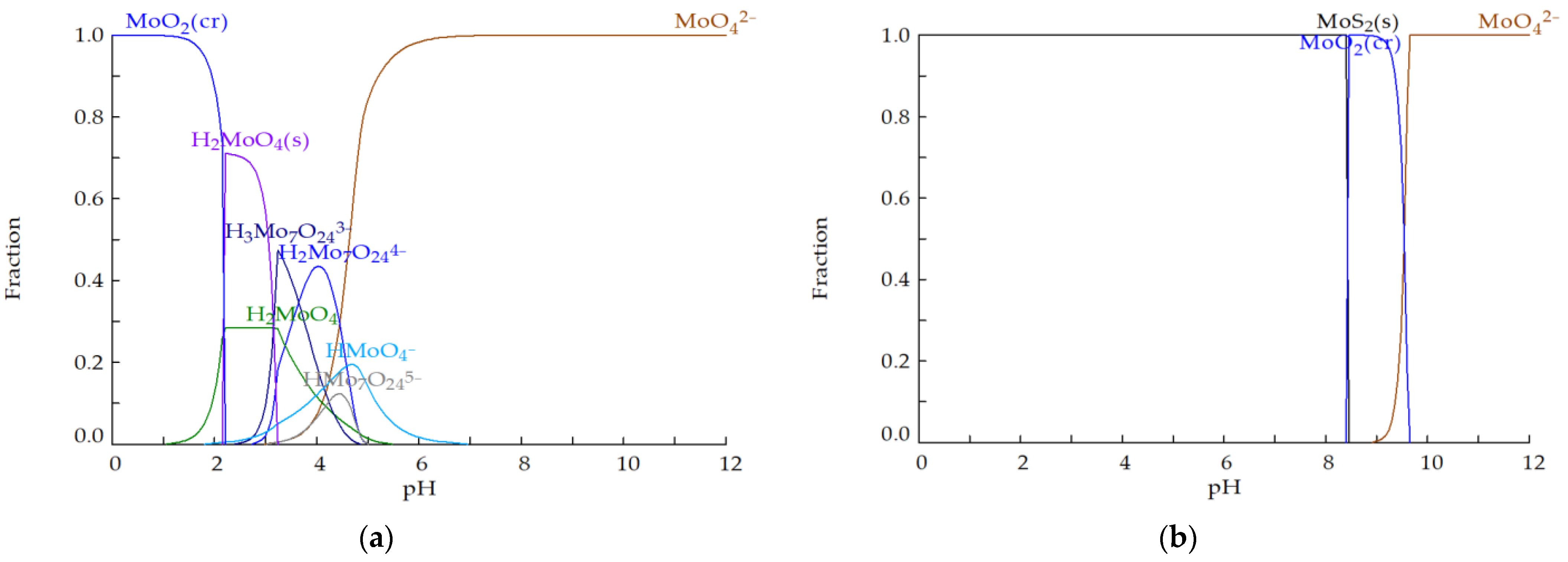
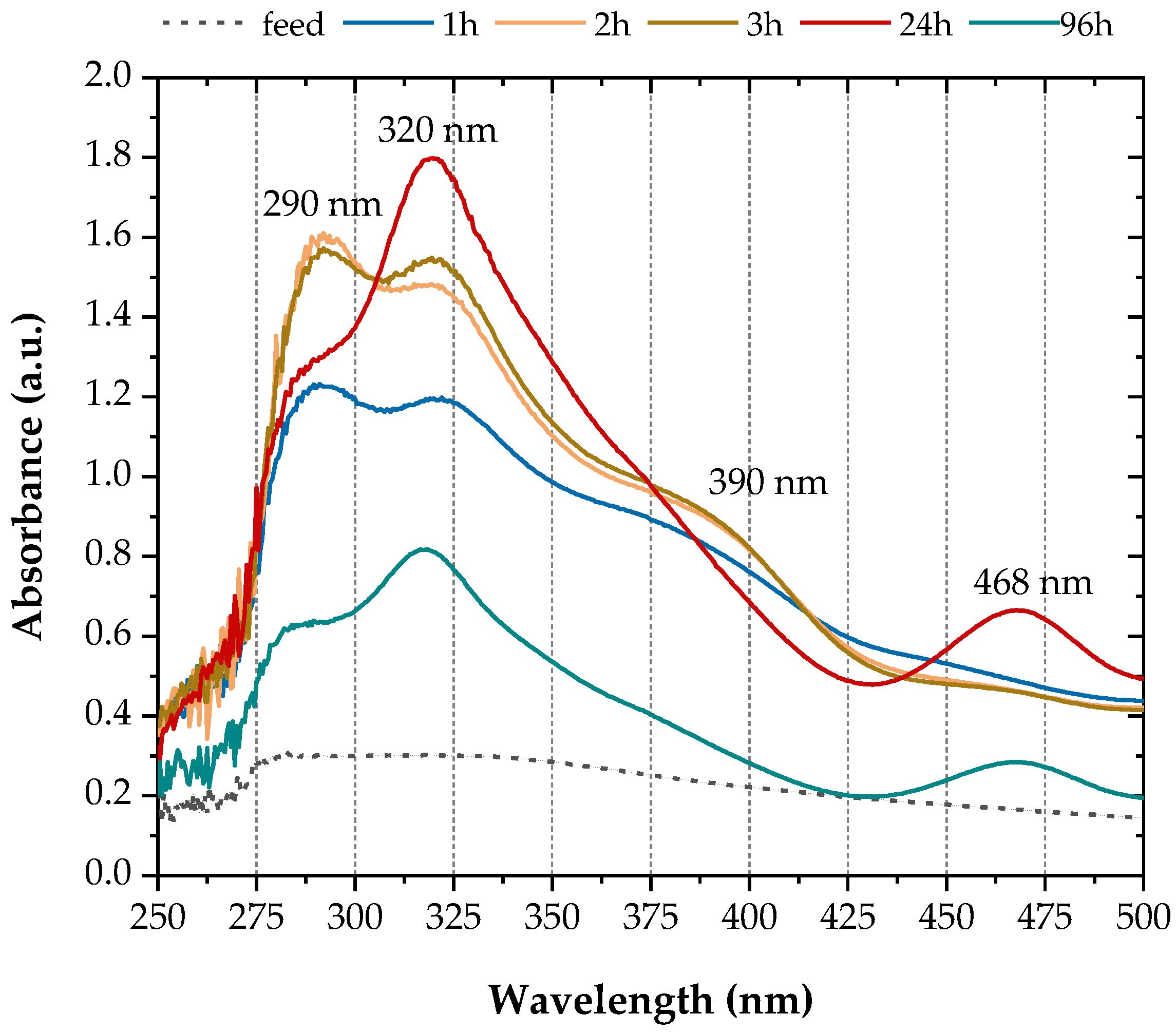

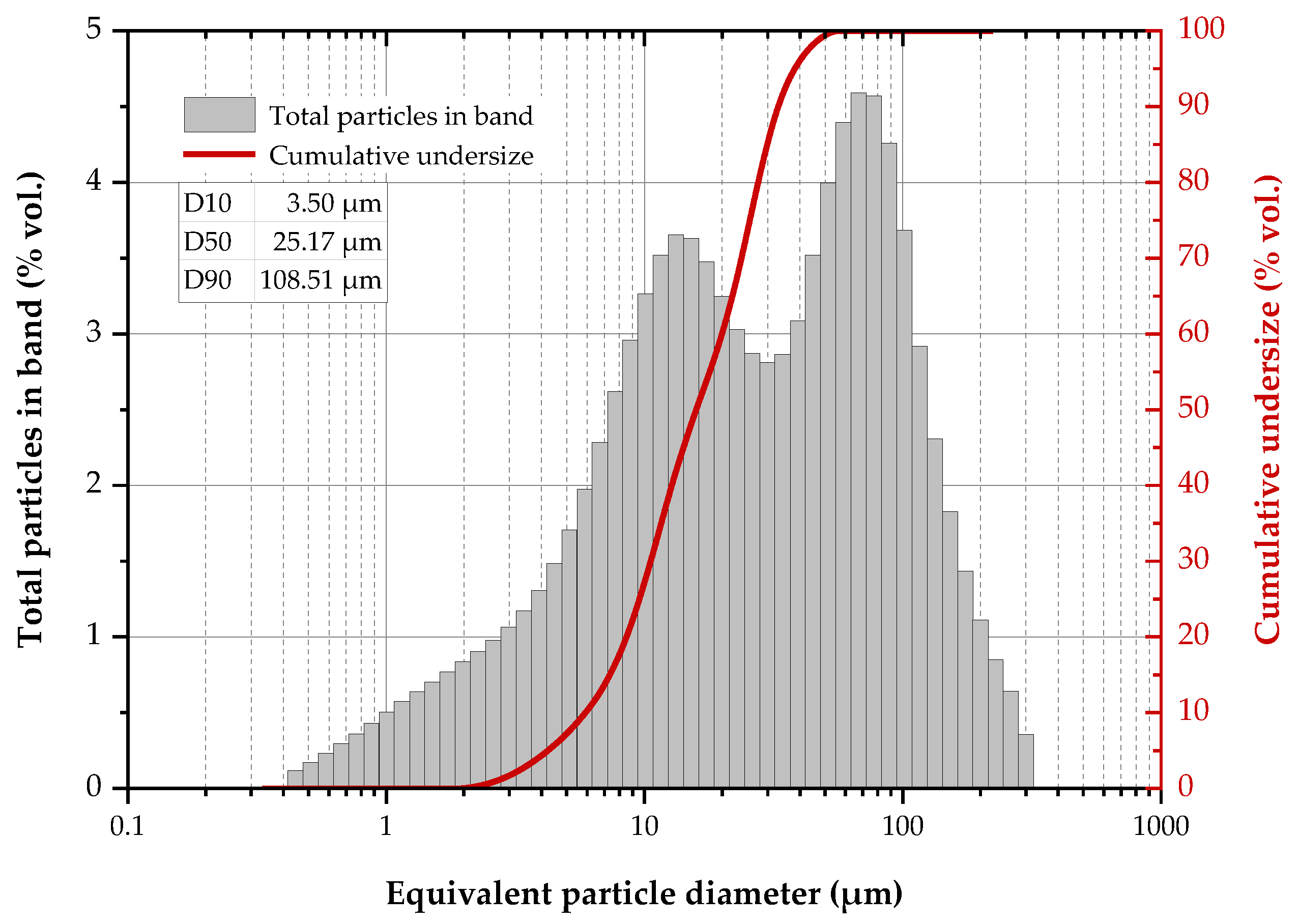
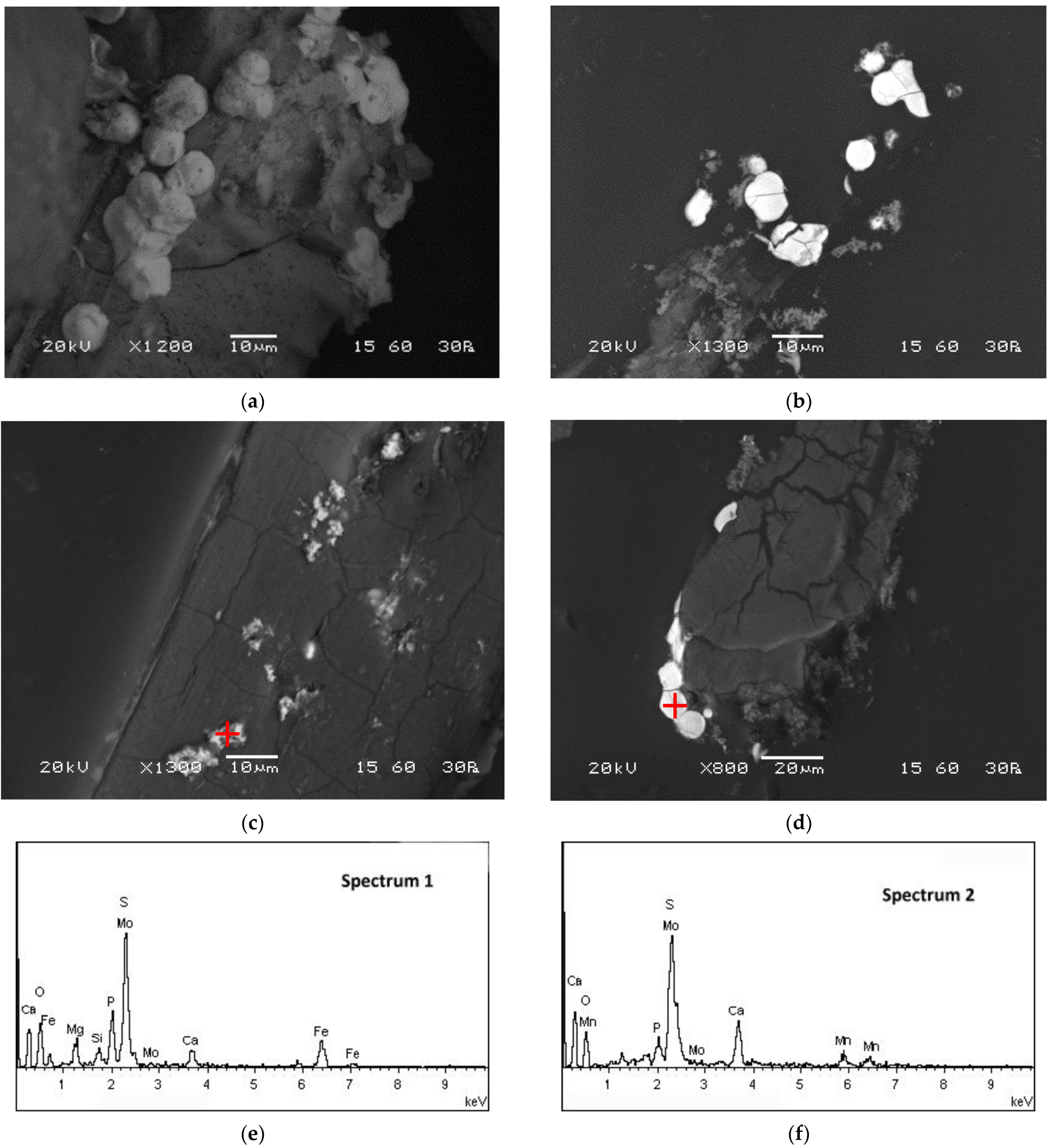
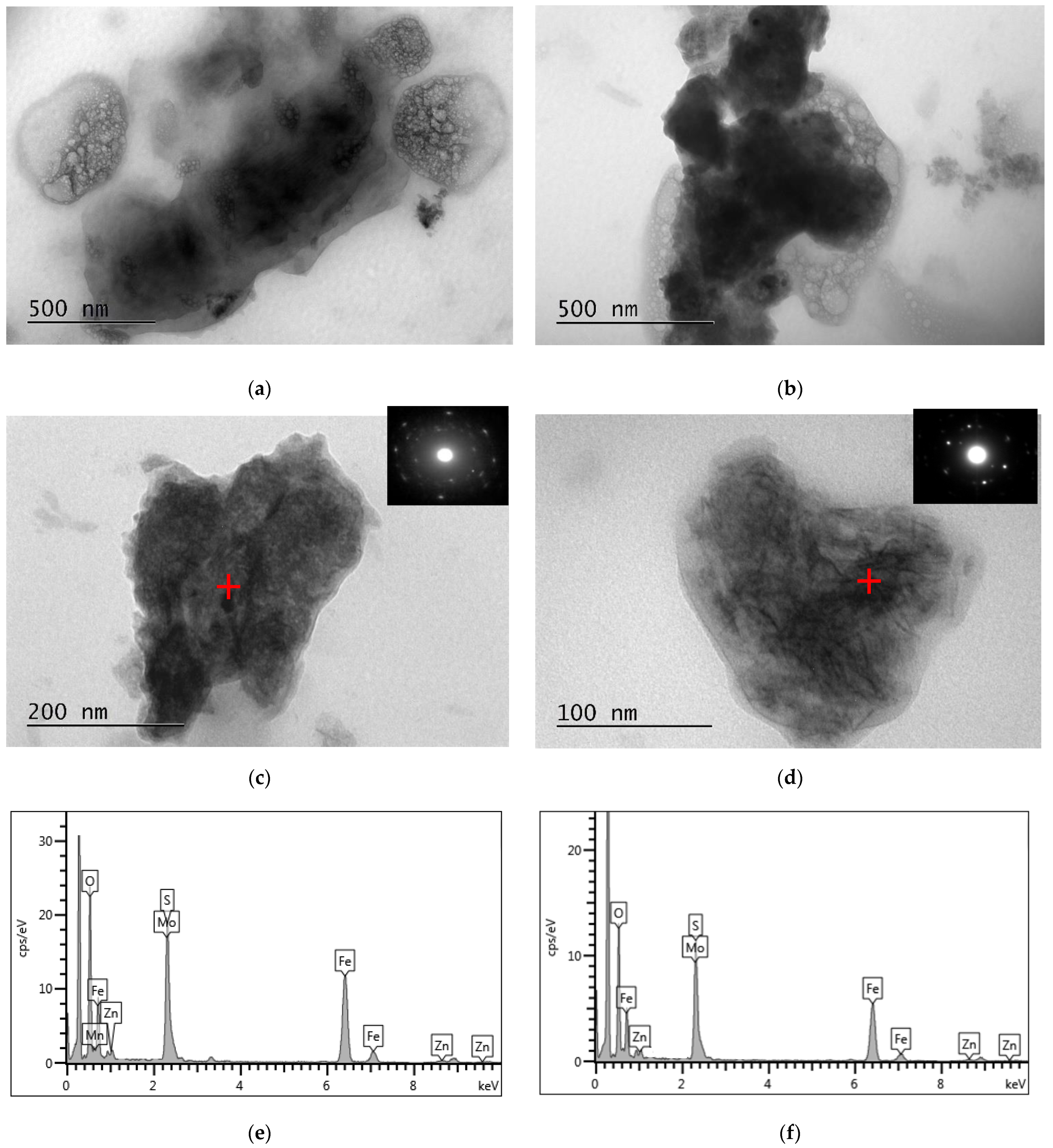
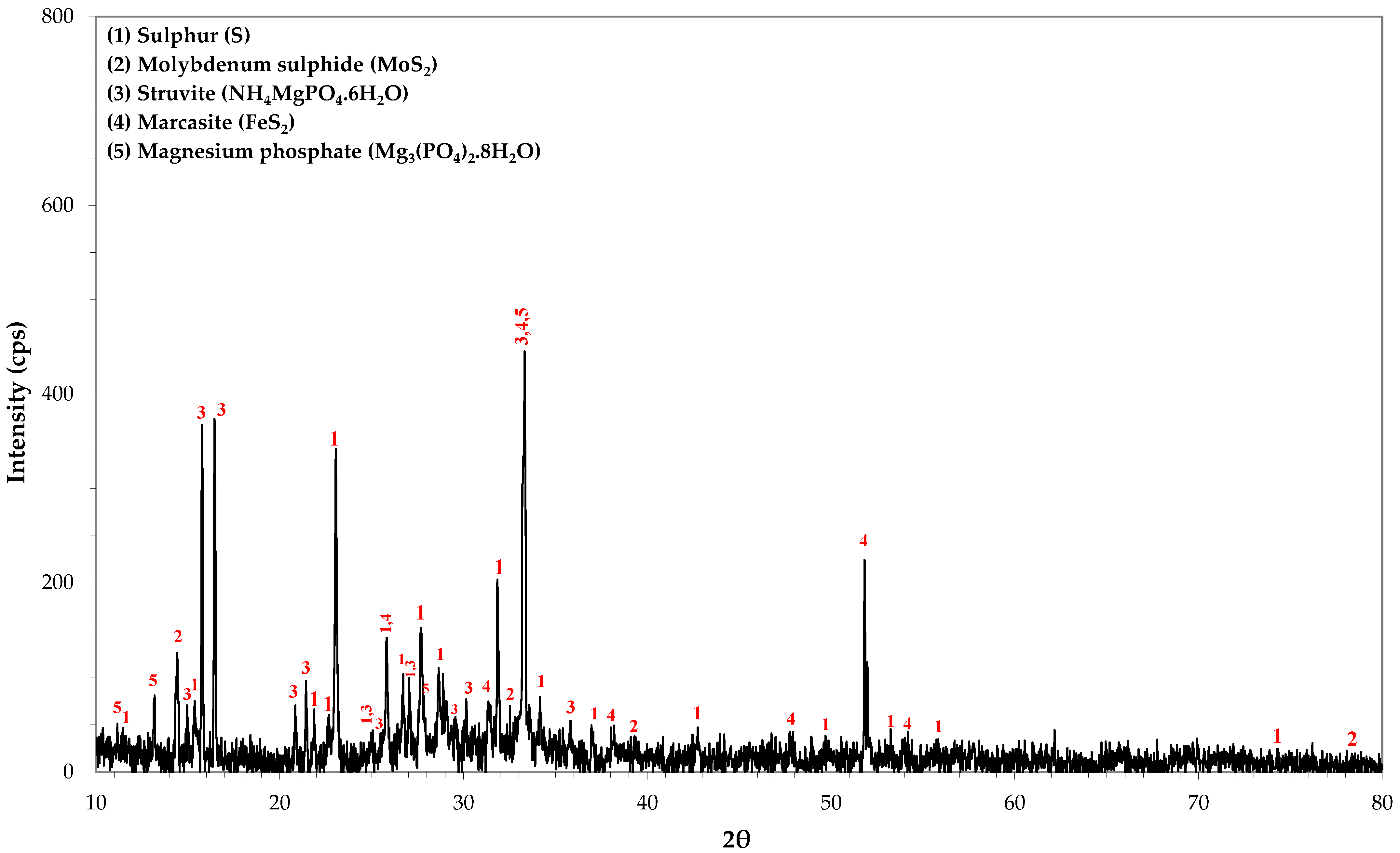
Disclaimer/Publisher’s Note: The statements, opinions and data contained in all publications are solely those of the individual author(s) and contributor(s) and not of MDPI and/or the editor(s). MDPI and/or the editor(s) disclaim responsibility for any injury to people or property resulting from any ideas, methods, instructions or products referred to in the content. |
© 2023 by the authors. Licensee MDPI, Basel, Switzerland. This article is an open access article distributed under the terms and conditions of the Creative Commons Attribution (CC BY) license (https://creativecommons.org/licenses/by/4.0/).
Share and Cite
Kousi, P.; Strongyli, D.-A.; Tsakiridis, P.E.; Hatzikioseyian, A.; Remoundaki, E. Immobilisation of Molybdenum in a Sulphate-Reducing Bioreactor. Separations 2024, 11, 9. https://doi.org/10.3390/separations11010009
Kousi P, Strongyli D-A, Tsakiridis PE, Hatzikioseyian A, Remoundaki E. Immobilisation of Molybdenum in a Sulphate-Reducing Bioreactor. Separations. 2024; 11(1):9. https://doi.org/10.3390/separations11010009
Chicago/Turabian StyleKousi, Pavlina, Dimitra-Artemis Strongyli, Petros E. Tsakiridis, Artin Hatzikioseyian, and Emmanouella Remoundaki. 2024. "Immobilisation of Molybdenum in a Sulphate-Reducing Bioreactor" Separations 11, no. 1: 9. https://doi.org/10.3390/separations11010009








